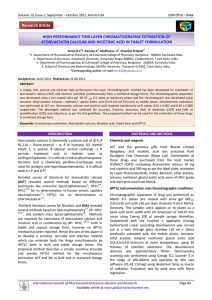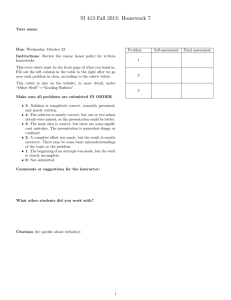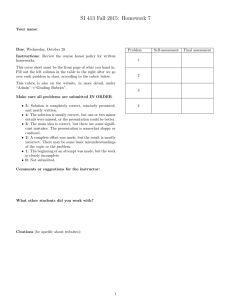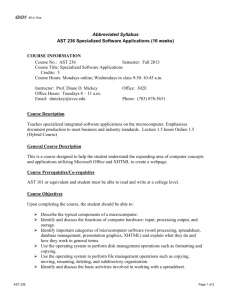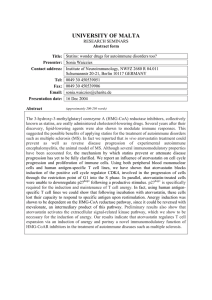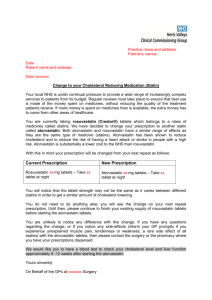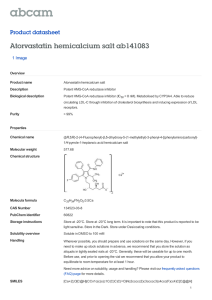Document 13309012
advertisement
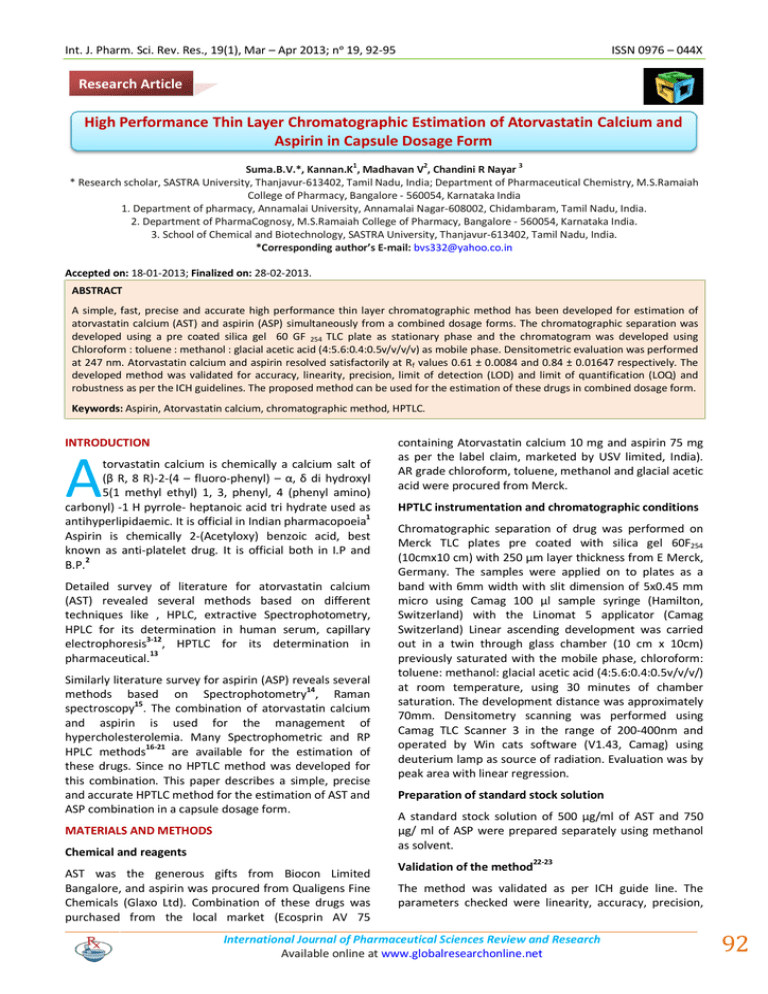
Int. J. Pharm. Sci. Rev. Res., 19(1), Mar – Apr 2013; nᵒ 19, 92-95 ISSN 0976 – 044X Research Article High Performance Thin Layer Chromatographic Estimation of Atorvastatin Calcium and Aspirin in Capsule Dosage Form 1 2 3 Suma.B.V.*, Kannan.K , Madhavan V , Chandini R Nayar * Research scholar, SASTRA University, Thanjavur-613402, Tamil Nadu, India; Department of Pharmaceutical Chemistry, M.S.Ramaiah College of Pharmacy, Bangalore - 560054, Karnataka India 1. Department of pharmacy, Annamalai University, Annamalai Nagar-608002, Chidambaram, Tamil Nadu, India. 2. Department of PharmaCognosy, M.S.Ramaiah College of Pharmacy, Bangalore - 560054, Karnataka India. 3. School of Chemical and Biotechnology, SASTRA University, Thanjavur-613402, Tamil Nadu, India. *Corresponding author’s E-mail: bvs332@yahoo.co.in Accepted on: 18-01-2013; Finalized on: 28-02-2013. ABSTRACT A simple, fast, precise and accurate high performance thin layer chromatographic method has been developed for estimation of atorvastatin calcium (AST) and aspirin (ASP) simultaneously from a combined dosage forms. The chromatographic separation was developed using a pre coated silica gel 60 GF 254 TLC plate as stationary phase and the chromatogram was developed using Chloroform : toluene : methanol : glacial acetic acid (4:5.6:0.4:0.5v/v/v/v) as mobile phase. Densitometric evaluation was performed at 247 nm. Atorvastatin calcium and aspirin resolved satisfactorily at Rf values 0.61 ± 0.0084 and 0.84 ± 0.01647 respectively. The developed method was validated for accuracy, linearity, precision, limit of detection (LOD) and limit of quantification (LOQ) and robustness as per the ICH guidelines. The proposed method can be used for the estimation of these drugs in combined dosage form. Keywords: Aspirin, Atorvastatin calcium, chromatographic method, HPTLC. INTRODUCTION A torvastatin calcium is chemically a calcium salt of (β R, 8 R)-2-(4 – fluoro-phenyl) – α, δ di hydroxyl 5(1 methyl ethyl) 1, 3, phenyl, 4 (phenyl amino) carbonyl) -1 H pyrrole- heptanoic acid tri hydrate used as antihyperlipidaemic. It is official in Indian pharmacopoeia1 Aspirin is chemically 2-(Acetyloxy) benzoic acid, best known as anti-platelet drug. It is official both in I.P and B.P.2 Detailed survey of literature for atorvastatin calcium (AST) revealed several methods based on different techniques like , HPLC, extractive Spectrophotometry, HPLC for its determination in human serum, capillary electrophoresis3-12, HPTLC for its determination in 13 pharmaceutical. Similarly literature survey for aspirin (ASP) reveals several methods based on Spectrophotometry14, Raman spectroscopy15. The combination of atorvastatin calcium and aspirin is used for the management of hypercholesterolemia. Many Spectrophometric and RP HPLC methods16-21 are available for the estimation of these drugs. Since no HPTLC method was developed for this combination. This paper describes a simple, precise and accurate HPTLC method for the estimation of AST and ASP combination in a capsule dosage form. MATERIALS AND METHODS Chemical and reagents AST was the generous gifts from Biocon Limited Bangalore, and aspirin was procured from Qualigens Fine Chemicals (Glaxo Ltd). Combination of these drugs was purchased from the local market (Ecosprin AV 75 containing Atorvastatin calcium 10 mg and aspirin 75 mg as per the label claim, marketed by USV limited, India). AR grade chloroform, toluene, methanol and glacial acetic acid were procured from Merck. HPTLC instrumentation and chromatographic conditions Chromatographic separation of drug was performed on Merck TLC plates pre coated with silica gel 60F254 (10cmx10 cm) with 250 µm layer thickness from E Merck, Germany. The samples were applied on to plates as a band with 6mm width with slit dimension of 5x0.45 mm micro using Camag 100 µl sample syringe (Hamilton, Switzerland) with the Linomat 5 applicator (Camag Switzerland) Linear ascending development was carried out in a twin through glass chamber (10 cm x 10cm) previously saturated with the mobile phase, chloroform: toluene: methanol: glacial acetic acid (4:5.6:0.4:0.5v/v/v/) at room temperature, using 30 minutes of chamber saturation. The development distance was approximately 70mm. Densitometry scanning was performed using Camag TLC Scanner 3 in the range of 200-400nm and operated by Win cats software (V1.43, Camag) using deuterium lamp as source of radiation. Evaluation was by peak area with linear regression. Preparation of standard stock solution A standard stock solution of 500 µg/ml of AST and 750 µg/ ml of ASP were prepared separately using methanol as solvent. Validation of the method 22-23 The method was validated as per ICH guide line. The parameters checked were linearity, accuracy, precision, International Journal of Pharmaceutical Sciences Review and Research Available online at www.globalresearchonline.net 92 Int. J. Pharm. Sci. Rev. Res., 19(1), Mar – Apr 2013; nᵒ 19, 92-95 limit of detection, limit of quantification, robustness and specificity. Calibration curve From the working standard solution of AST (500 µg/ml) and ASP(750 µg/ ml), 1-3µl solutions and 1.5-5.5µl solutions were spotted for AST and ASP respectively on a HPTLC plate to obtain a final concentration of 500 ng / spot to 1500 ng/ spot for AST and 1125 ng/spot to 4125 ng/spot for ASP. The plates were then developed as per procedure described above and the peak areas were plotted against corresponding concentration to obtain the calibration curves. Specificity The specificity of the method was determined by analysis of standard drug and samples. The band for AST and ASP in the sample was identified by comparing the Rf value and the spectrum of the band with those of the band obtained from a standard drug solution. Accuracy: (% Recovery) For accuracy of method, recovery studies were carried out by applying a known amount of standard AST and ASP at a level of 80,100,120 % to the sample solution (standard addition method). Three determinations were performed at each level, using same chromatographic condition as describe above. Precision: (Reproducibility) The precision of the method was verified by performing the intraday and interday precision. The intraday and interday precision of the proposed method was determined by estimating the corresponding response three times on the same day and on three different days over a period of one week for five concentration of AST (500,750,1000,1250,1500ng/spot) and ASP (1125,1875,2625,3375,4125ng/spot). The results are expressed in terms of relative standard deviation. ISSN 0976 – 044X twenty tablets were weighed and average weight was determined, powered, from this equivalent weight of 25 mg for AST and 37.5 mg of ASP was transferred into a 50 ml volumetric flask, containing 15 ml of methanol and sonicated for 30 minutes, filtered through Whatmann filter paper No.41and then volume was made up to 50 ml with methanol. From this stock solution 1000 ng/ spot was spotted for AST and 2625 ng/spot was spotted for ASP on a HPTLC plate and chromatogram was developed as described earlier. The analysis was repeated for three times and interference for excipients was analyzed. RESULTS AND DISCUSSION To optimize the HPTLC parameters, several mobile phase were tried and satisfactory results were obtained by using the mobile phase chloroform: toluene: methanol: glacial acetic acid (4:5.6:0.4:0.5v/v/v/v). Quantification was achieved under UV detection at 247nm. A sharp and symmetrical peak was resolved with an Rf of 0.61 ± 0.0084 for AST and 0.84 ± 0.01647 for ASP as shown in the figure 1 and table 1. The proposed method was found to be simple and sensitive with linearity in the concentration range of 500 ng / spot to 1500 ng/ spot for AST and 1125 ng/spot to 4125 ng/spot for ASP, the linearity curve are shown in the figure 2 and 3 respectively. The method was found to be accurate and precise indicated by results of recovery studies and % RSD not more than 2%, LOD and LOQ for AST were found to be 1.299 ng/spot and 3.9374 ng/spot and for ASP were 2.8 ng/spot and 8.4857 ng/spot respectively as shown in the table 2. The proposed method was found to be specific as there is no interference from common capsule excipients. Peak purity values for peaks of both AST and ASP confirmed the specificity as shown in the figure 4 and 5. Limit of Detection (LOD) and Limit of quantification (LOQ) The LOD and LOQ were calculated using following equations as per International conference on Harmonization guide line: LOD= 3.3 x σ/S LOQ= 10 x σ/S Where σ is standard deviation of the response and S is the standard deviation of y intercept of regression lines. Robustness Robustness was checked by making a slight deliberate change in the experimental procedure like slight change in the mobile phase, saturation time and the values were compared with the original chromatographic conditions. Figure 1: Chromatogram of AST and ASP Analysis of the marketed products To find the content of the marketed formulation, (Ecosprin, Label Claim, 10 mg of AST and 75 mg of ASP), International Journal of Pharmaceutical Sciences Review and Research Available online at www.globalresearchonline.net 93 Int. J. Pharm. Sci. Rev. Res., 19(1), Mar – Apr 2013; nᵒ 19, 92-95 ISSN 0976 – 044X AREA UNDER THE CURVE Calibration curve of AST 5000 y = 3.3884x - 730.51 R2 = 0.9991 4000 3000 2000 1000 0 0 500 1000 1500 2000 CONCENTRATION in ng/spot Figure 2: Representative of linearity of atorvastatin calcium. (Average of six trials) Figure 6: Overlay spectra of Standard AST and Standard ASP AREA UNDER THE CURVE Calibration curve of ASP 7000 Table 1: Regression analysis of the calibration curve of atorvastatin calcium and aspirin by the proposed HPTLC method y = 1.3942x + 494.48 R2 = 0.9955 6000 5000 4000 3000 Parameters 2000 Linearity range 1000 0 0 1000 2000 3000 4000 5000 CONCENTRATION in ng/spot Figure 3: Representative of linearity of aspirin. (Average of six trials) AST ASP 500-1500ng/spot 1125-4125ng/spot Slope 3.3884 1.3942 Intercept 730.51 494.48 Correlation coefficient * 0.9991 0.9955 * Indicates mean of six observation Table 2: Summary of validation parameters for atorvastatin calcium and aspirin by the proposed HPTLC method Parameters AST ASP 101.31 ± 0.7066 99.42 ± 0.1986 Recovery studies(% ± SD) 80% 100% 120% 99.61 ± 0.4350 99.61 ± 0.4632 99.39 ± 0.8989 98.24 ± 0.2427 99.68 ±0.1026 99.46 ±0.0296 LOD 1.299 ng/spot 2.8 ng/spot LOQ 3.9374 ng/spot 8.4857 ng/spot Precision (± RSD) # Inter day Intra day 0.2159-1.8226 0.3436-0.9199 0.0088-0.043 0.019-0.2336 Accuracy (% ± SD) # Figure 4: UV absorption spectra of Standard AST and Sample AST ± indicates standard deviation # Average of three trials CONCLUSION The developed HPTLC method for the simultaneous determination of AST and ASP can be used for routine analysis of both these components in combined dosage form. Figure 5: UV absorption spectra of Standard ASP and Sample ASP Acknowledgement: The authors are thankful to Gokula Education Foundation for providing necessary facilities to carry out the research work and Biocon Limited Bangalore, for providing a gift sample of standard atorvastatin calcium. International Journal of Pharmaceutical Sciences Review and Research Available online at www.globalresearchonline.net 94 Int. J. Pharm. Sci. Rev. Res., 19(1), Mar – Apr 2013; nᵒ 19, 92-95 REFERENCES 1. Indian Pharmacopoeia Health ministry of India, 2010, Vol.II 849. 2. Indian Pharmacopoeia Health ministry of India, 2010, Vol.II 1776, British Pharmacopoeia, the stationery office on behalf of the medicines and health care products regulatory agency, 2, 2007, 1466-1467. 3. 4. William W. Bullen, Ronald A. Miller, Roger N. Hayes, Development and validation of a high-performance liquid chromatography tandem mass spectrometry assay for atorvastatin, ortho-hydroxy atorvastatin, and parahydroxy atorvastatin in human, dog, and rat plasma, J American Society for Mass Spectrometry. 10(1), 1999, 5566. Mohammed Jemal, Zheng Ouyang, Bang-Chi Chen, Deborah Teitz, Quantitation of atrovastatin and its biotransformation products in human serum by HPLC with electro spray tandem mass spectrometry, Rapid Communications in Mass Spectrometry. 13(11), 1999, 1003-1015. ISSN 0976 – 044X 12. Ramakrishna Nirogi, Koteshwara Mudigonda, Vishwottam Kandikere Chromatography–mass spectrometry methods for the quantitation of statins in biological samples, J of Pharmaceutical and Biomedical Analysis, 44, 2007, 379– 387. 13. S. R. Dhaneshwar, S. Yadav, A. Mhaske and S. Kadam, HPTLC Method for Determination of Content Uni- formity of Atorvastatin Calcium Tablets, Indian Journal of Pharmaceutical Sciences. 67, 2005, 182-186. 14. J.Anwar and T.A. Awan,, Spectrophotometric determination of aspirin in pharmaceutical Formulations by oxidation with Potassium dichromate, J Chem Soc Pak 12(1), 1990. 15. Szostak R, Mazurek S, Quantitative determination of acetylsalicylic acid and acetaminophen in tablets by FTRaman spectroscopy Analyst, 127, 2002, 144-148. 16. Patel G. F1, Vekariya N. R.1, Dholakiya R. B Estimation of Aspirin and Atorvastatin Calcium in Combine Dosage Form Using Derivative Spectrophotometric Method, International Journal of Pharmaceutical Research. 2(1), 2010 page no 62-65 17. D.A.Shah, K.K.Bhatt, R.S.Mehta, M.B.Shankar, S.L.Baldania, T.R. Gandhi , development and validation of a RP HPLC method for determination of atorvastatin calcium and aspirin in a capsule dosage form Indian journal of pharmaceutical sciences. 69 (4), 2007, 546-549 5. Xiu-Sheng Miao, Chris D. Metcalfe, Determination of pharmaceuticals in aqueous samples using positive and negative voltage switching microbore liquid chromatography/electrospray ionization tandem mass spectrometry, J of Mass Spectrometry. 38(1), 2003, 27– 34. 6. Sidika Ertürk, Esra Sevinç Aktaş, Lale Ersoy, Samiye Fiçicioğlu, An HPLC method for the determination of atorvastatin and its impurities in bulk drug and tablets, J of Pharmaceutical and Biomedical Analysis. 33(5), 2003, 1017-1023. 18. D. N. Vora and A. A. Kadav, Validated Ultra HPLC Method for the Simultaneous Determination of Atorvastatin, Aspirin, and their Degradation Products in Capsules Journal of Liquid Chromatography & Related Technologies, 31(18), January 2008, 2821-2837. 7. Nevin Erk, Extractive Spectrophotometric Determination of Atorvastatin in Bulk and Pharmaceutical Formulations, Analytical Letters. 36(12), 2003, 2699-2711. 19. 8. Altuntas TG, Erk N, Determination of atorvastatin in bulk drug, tablets, and human plasma, J of liquid chromatographic related technology Liquid chromatographic. 27(1), 2004, 83-93. G. F. Patel, N. R. Vekariya, R. B. Dholakiya, G. K. Ramani, RP-HPLC Estimation of Aspirin and Atorvastatin Calcium in Combined Dosage Forms Journal of Pharmacy Research 2(8),2009, 1274-1275. 20. 9. Gholamreza Bahrami, Bahareh Mohammadi, Shahla Mirzaeei, Amir Kiani, Determination of atorvastatin in human serum by reversed-phase high-performance liquid chromatography with UV detection, J of Chromatography B November 826( 1-2, 5), 2005, 41-45. Suma BV,.Kannan K. Madhavan V, Chandini R. nayar,Simultaneous Estimation and Validation of Atorvastatin Calcium and Aspirin in Combined Capsule Dosage Form by RP HPLC Method,E-Journal of Chemistry, 9(3), 2012, 1449-1456. 21. Satheesh K. Shetty, Koduru V. Surendranath, Pullapanthula Radhakrishnanand, Roshan M. Borkar, Prashant S. Devrukhakar, Johnson Jogul, Upendra M. Tripathi Quantitative Application to a Polypill by the Development of Stability Indicating LC Method for the Simultaneous Estimation of Aspirin, Atorvastatin, Atenolol and Losartan Potassium American Journal of Analytical Chemistry, 2, 2010, 59-69. 22. ICH, Q2B Validation of Analytical Procedure: Methodology, in: Proceeding of theInternational Conference on Harmonization, Geneva, March 1996. 23. ICH, Guidance on Analytical Method Validation, in: Proceedings of International Convention on Quality for the Pharmaceutical Industry, Toronto, Canada, September 2002. 10. 11. Iolanda Mazzucchelli, Manuela Rapetti, Cinzia Fattore, Valentina Franco, Giuliana Gatti, Emilio Perucca Determination of atorvastatin and metabolites in human plasma with solid-phase extraction followed by LCtandem MS,Analytical and Bioanalytical Chemistry. 401 (3), 2005, 1013-1021. Stanisz B and Kania L.Validation of HPLC Method for Determination of Atorvastatin in Tablets and for Monitoring in Solid Phase, Acta Poloniae Pharmaceutica. 63 (6), 2006, 471-476. Source of Support: Nil, Conflict of Interest: None. International Journal of Pharmaceutical Sciences Review and Research Available online at www.globalresearchonline.net 95
